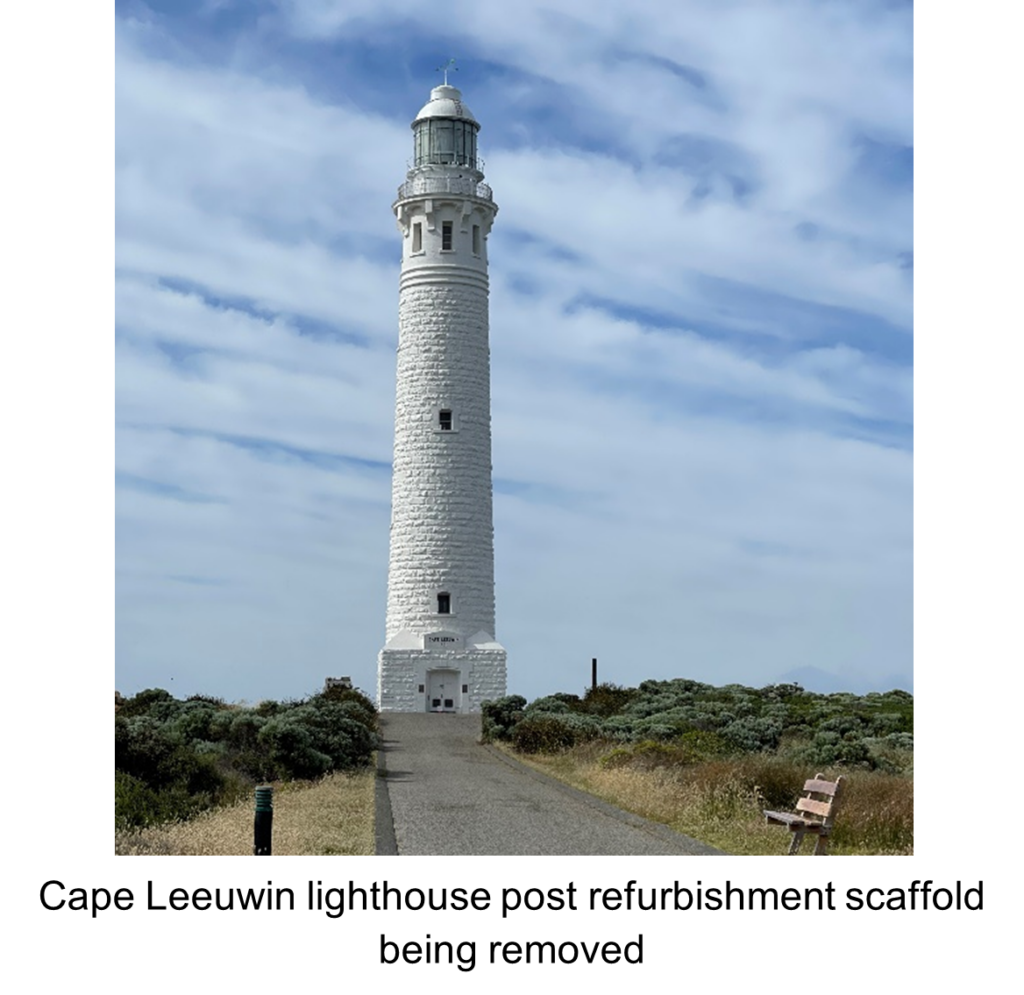Australia
The Australian Maritime Safety Authority (AMSA) Aids to Navigation (AtoN) network comprises of 484 AtoNs at 385 sites Australia-wide. The structures vary from stainless steel towers and heritage lighthouses to buoys.
General maintenance is carried out through an outsourced contract, with major repairs, renewals and technology enhancements delivered through AMSA’s Capital Works Programme.
AMSA has 52 heritage lighthouses within its network of AtoN, AMSA operates a programme for the removal of hazardous coatings and refurbishment of heritage lighthouses.
Lighthouses are prioritised in a risk-based assessment, criteria such as condition of coatings, safety, and associated structure deterioration such as severe corrosion.
Two recent refurbishments undertaken are the Rottnest Island and Cape Leeuwin Lighthouses located in Western Australia.
Rottnest Island – lighthouse refurbishment
The Rottnest Island Lighthouse (also known as Wadjemup) built in 1896 is one of two on the island. The current lighthouse was constructed to replace the original 1850 tower, the lighthouse has guided shipping away from the shallows and reefs of the island and into the Port of Fremantle for over 125 years.
As a prime example of 19th century navigation and maritime development, the heritage-listed limestone tower has maintained high significance and continues use of its original 1st Order lantern and lens, run on a modern automation system.
It is one of six AMSA lighthouses to continue to operate on a mercury bath, and one of three with an iron spiral stair supported by a central weight tube.
In 2021-22, a major structure refurbishment of the 38 metre tower was undertaken by AMSA. Lead paint layers were removed, and all internal and external surfaces were repainted. Corrosion damage throughout the lighthouse was repaired, and the lantern room reglazed.
The works were considered positive to the overall heritage values of the lighthouse and larger lightstation.
Cape Leeuwin – lighthouse refurbishment
The Cape Leeuwin Lighthouse is located at the south-westerly tip of Western Australia.
The 39 metre limestone lighthouse was first lit in 1896 and warns of the cape itself and the multiple hazards to navigation that exist. The lighthouse also now has an Automatic Identification System for vessel tracking.
As a beacon for ships crossing the Indian Ocean, the light from the 1st Order bi-form lens was oftentimes the first sight of the mainland. The significance of the lighthouse stretches from its impressive architectural elements to its mercury bath which spins the lens seamlessly each night. The light has been automated since 1992.
Project works are currently nearing completion at the lighthouse, removing existing lead paint layers and repainting all internal and external surfaces. Limestone weathered over the years are undergoing reparation, and the mercury bath itself is being serviced.
The original weathervane, which was removed from the top of the tower some decades ago, has been reinstalled as part of the works. Removal of the modern cement topping to the lantern balcony revealed the original rainwater collection drainage system once utilised. This drainage system, which fed into a water tank located inside the lantern room, has been left uncovered to allow visitors to the site to see this unique feature.
Considered necessary to improve the condition of the tower, the works will allow for the continued preservation of both a critical aid to navigation, and a site of extreme heritage value.
A challenge at both sites
A challenge at both sites was the repair of corrosion to the internal floor beams that are embedded in the stonework which has been hidden for many years, stone was excavated around each beam to allow for the beams to be prepared and painted.
Upon excavation of the stone, severe corrosion was evident to the majority of beams with most exhibiting more than 50% loss of section. To repair the beams approximately 500mm of the beams were removed and new custom fabricated beam section was pre painted and butt welded. The weld margins were prepared and painted with the remained of the beams. To limit the potential for future corrosion of the beams the excavated stone was not reinstated leaving an air pocket around the beams.





Author: Angela Karamihas
Rapporteur: Paul Ridgway
